Deactivated Nazi Walther P38 9mm Pistol Mauser BYF 1943







Deactivated Nazi Walther P38 9mm Pistol. Mauser BYF 43 dated production in very good overall deactivated condition, with matching numbers. full moving parts.
The Walther P38 came into service with the German armed forces in 1939. It replaced the Luger, which was too complicated and expensive. The P38 soon gained a reputation for reliability and it was quite usual to leave the weapon free of oil during the harsh Russian winter and it worked perfectly. It was also the first military issue weapon to incorporate a double action trigger.
Very rare Reich Chancellery (Reichskanzlei) Berlin, Embossed book plate





An example how it would have looked before it was removed from the book.

Very rare embossed book plate taken from the Reich Chancellery (Reichskanzlei) in Berlin. The plate is made in embossed pressed cardboard with gilt finish on the obverse. Has been removed from a book, with remnants of the reverse.
It shows a rectangular oak leaves motif, in the centre is an eagle with swastika and under it the writing "Bücherei der Reichskanzlei" (Library of the Reich Chancellery).
Plate is used but remains in excellent condition. A rare historical piece to find.
Measurements: 7 cm X 8,5 cm, comes with COA.
Original Small Identified NSDAP Golden Party Badge by Joseph Fuess, with research
SA (Musician) (Sturmabteilung, Storm Troopers)




In the photo above Alfons can be seen wearing this badge on this tie.
A well-preserved example of a NSDAP Golden Party Badge constructed of gilded tombac and multi-coloured enamels. manufactured by Joseph Fuess, with research file including a photo of Alfons Breumaier.
The obverse presents with a central black mobile swastika within a bed of white enamels, with a red enamelled edge inscribed “NATIONAL-SOZIALISTISCHE D.A.P.” (“National Socialist German Workers’ Party”). The reverse presents with a horizontal pinback and NSDAP member number “45148”. The badge measures 24 mm in diameter and weighs 12.6 grams.

First name: Alfons
Last Name: Breumaier
Gender: Male
Born: May 4, 1908
Place of birth: Augsburg/Augsburg-Stadt district/Swabia/Bavaria
Joined: October 6, 1926
Membership: 45148
NSGE badge
Awarded: November 21, 1933
Biography: District Savings Bank Assistant (Augsburg), Main Branch Manager (Local Group 27), Manager (Local Group, Film Department), SA (Musician)
(Sturmabteilung, Storm Troopers), also known as "Brown Shirts," the Nazi Party militia that helped Adolf Hitler rise to power in Germany. Created in 1922, the SA's supposed purpose was to guard Nazi Party meetings, but in actuality, Hitler meant for the group to serve as the Nazi army. The SA was extremely antisemitic and antidemocratic in its military activities. Its members were mainly lower-middle class Germans who had lost their jobs due to the country's economic problems. The SA gave them something to be part of and proud of. They engaged in street fights with their political enemies, practiced pseudo-military exercises, and terrorized Germany. Ernst Rohm became the Supreme Commander of the SA in 1924. Around that time, Hitler began calling for the use of legal means to take control of Germany. Rohm was not satisfied with this: he wanted the SA to be the basis of a revitalized German army that would take power by force. Hitler rejected Rohm, and in 1925, Rohm stepped down. However, Hitler invited him back to his old job in 1930 after the Nazis' electoral victory, and ordered him to rebuild the SA.






Residence: Augsburg-Bärenkeller/Augsburg-Stadt district
Apartment: Bärenkeller Siedlung 54
Swabia district
Residence: 1: Außere Ufer str. 4 in Augsburg-Oberhausen and Local Group 16 in Augsburg
Residence: 2: Augsburger str. 76 in Gersthofen/Augsburg-Land district, Below: Alfons home as it is today.

Remarks: "Breumaier" (S-162, S-299); "Breumair" (S-161, S-162); not a Blood Order recipient (S-1206)
German NSDAP (Nazi) Party, Golden Party Badge. The NSDAP, Nationalsozialistische Deutsche Arbeiterpartei, (National Socialist German Worker’s Party), Golden Party badge was instituted by Adolf Hitler on October 13TH 1933 to reward those NSDAP members who had served the party continuously from February 27TH 1925, and held a party membership number of 100,000, or below. The originally bestowal of the badges was on November 9TH 1933, and further regulations dictated that Hitler held the right to render the award to personnel who had provided exemplary service to the NSDAP or Greater Germany. The badge was awarded in two sizes with a small, 1″, (25mm), diameter badge for wear on civilian clothing and a larger, 1 1/4″, (30.5mm), badge for wear on political or military uniforms. The introductory regulations stated that the recipient must have continuous, unbroken service with the party and on leaving the party the badge could no longer be worn. The regulations also stipulated that on the death of the recipient the family may keep the badge as a memento. Of Note: Due to the “continuous” service clause in the award criteria, anyone who’s service time had been interrupted were ineligible for award of the badge. As a result of this criteria it is estimated that only about 24,000 badges were awarded out of the possible 100,000.
Early WW2 Nazi K98 dated 1939. ERMA - Erfurter Maschinenfabrik
under secret makers code "27










This is an early Second World War manufactured Nazi K98 dated 1939. It was made by ERMA - Erfurter Maschinenfabrik under secret makers code "27". In late 1938 Erma transitioned from the S/27 coding to 27, with 1939 being the first full year of K98 production using this new code, and with an estimated 135,700 rifles completed. This example is a fairly early one with a "d" suffix serial number meaning its around gun number 51,021st of 1939 production. The bolt is matched to itself number 1165.
This K98 was almost certainly being made in readiness for the invasion of Poland in September 1939. At this early stage of the war German K98 production across all manufactures was still very low.
Original WW2 German K98 rifle sling





lovely original K98 sling, Supple leather still with cross hatching, buckle maker marked Linden und Funke Iserlohn, the keeper has correct steel stud and all stitching is intact, the back of the keeper has eagle and swastika stamp WaA 721 for K. Berger.
WW2 Visor cap for enlisted men or non-commissioned
officers of the Wehrmacht artillery








Superb doe skin Visor cap for enlisted men or non-commissioned officers of the Wehrmacht artillery. The weapon color is red, corresponding to the troop affiliation.
The imperial eagle and the oak leaf wreath are made of aluminum and are very well preserved.
The leather and fabric are free of any notable defects; only slight abrasion is visible on the inside of the edging. The umbrella sits firmly and securely.
The hat is in lightly worn, very good condition! The inside of the peaked cap features a celluloid trapeze of the manufacturer and the wearer's name.
wearer's name: Beckmerhagen
Unit: S./AEA 2/169 (Artillery Replacement Division)
Head size (measured inside):circumference 55 cm
Lightly worn peaked cap with wearer's name in very good condition
WW2 German Pair of Luftwaffe Flak Regiment 4 Shoulder Straps/Boards



An excellent pair of uniform removed Sew in Shoulder Straps/boards to an Oberfeldwebel NCO in Luftwaffe Flak regiment 4. Constructed in the usual blue grey wool trimmed with the red waffenfarbe of artillery and silver tresse, the rank denoted by two aluminium pips. Between the pips is the 4 of the regiment with subdued finish.
German: Flak-Division 4
Luftverteidigungs-Kommando (Nr. 4) Düsseldorf
Luftverteidigungs-Kommando Essen
Active : 1 July 1938 – 18 April 1945
Country : Nazi Germany
Branch : Luftwaffe
Type : Flak
Role : Anti-aircraft warfare
Size : Division
Engagements :
Bombing of Duisburg in World War II
Battle of the Ruhr
Western Front
Ruhr pocket
WW2 Luftwaffe Flak Artillery Regiment NCO collar tabs


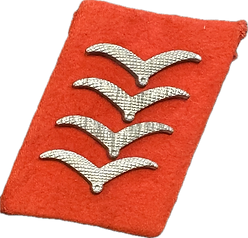
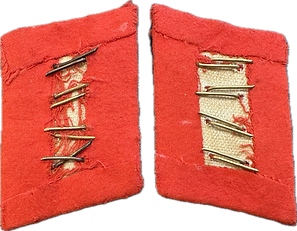

Truly issued and worn, matching pair of WH (Luftwaffe) bright-red-coloured NCO collar patches / tabs, as was intended for usage by a member within Flak Artillery regiment. In the typical bright red coloured smooth felt-like type wool, The patches were clearly issued and once tunic attached by means of hand stitching, they show some moderate age, wear and staining.
Both tabs show four identical aluminium zinc based gulls, period attached and are both backed with the beige coloured typical buckram based material.
This attractive Kragenspiegel pair was recently found at a private household in Germany and was never before in collectors hands, Genuine Flak Artillery LW collar tabs are nowadays not that easily encountered.
WW2 German Black wound badge L/11 Deumer



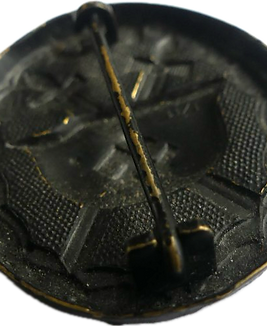
A lovely early black wound badge L/11 Deumer!
The reverse of the black wound badge L/11 Deumer features a hollow back is clearly maker marked “L/11 “(Wilhelm Deumer Ludenscheid) . The pin, hinge and catch are all intact and in well-working condition. The black paint remains 90% intact! 44.78mm tall by 37.26mm wide.
WW2 German 1st Pattern Luftwaffe Gravity Knife SMF Solingen







This 1st Pattern Luftwaffe Gravity Knife is a beautiful, well-used knife, with great character. All of the metalwork is nice and clean, showing traces of honest wear as well as an appealing shine. The blade has a nice look marked SMF Solingen Rostfrei, showing marks from having been lightly sharpened in the past. The knife functions properly, just as it did when it was new, with no faults to the mechanism. The wooden grips show minor darkening from handling and age, but are complete, with only minor marks. The swivel loop for retaining a lanyard is present, and the functional spike has the expected “Luftamt” 5 Luftwaffe proof mark near the base. This 1st Pattern Luftwaffe Gravity Knife is a nice, complete, representative example, with the look of something that was used and cared for in the field. It displays very well, and remains in excellent condition
The “Flieger-Kappmesser” (Flyer’s Jackknife) was introduced by the German Luftwaffe in 1937. Although this knife has become indelibly linked with German paratroopers, it was in fact intended for issue to all Luftwaffe air crew. This iconic WWII German knife had a distinctive look, with wooden grips and a four inc, gravity propelled, locking blade, as well as a spike which could be used to pick apart knots. The trousers issued to members of Fallschirmjäger units were outfitted with a special pocket intended for carrying this important tool, which in the reality of war, could also be used as a fighting weapon. In 1943, a second, “takedown” form of this knife appeared, with features which allowed for the easy disassembly of the knife for cleaning and maintenance.
WW2 German Doppelfernrohr (double telescope) 10 x 80 Flak Artillery optics




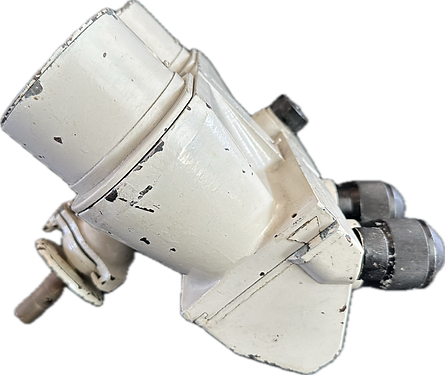






A genuine set German World War Two Doppelfernrohr (double telescope) 10 x 80 German optics often used by Flak Artillery ground crews for spotting & identifying enemy aircraft & for directing the crew served Range Finders. Used in conjunction with the Flak 36 88 mm guns ,There are adjustments for eye relief, width and a selection of various tinted filters, which rotate into place using the control on the left side. The dial is labeled klar (clear), hell (light), mittel (medium), and dunkel (dark). The right side of the binocular body is marked: 75212. under this 59962 'D.F.' Is the abbreviation for Doppelfernrohr (double telescope), with 10 x 80 indicating the magnification power of the optics. The German wartime three letter code 'cxn' stands for Emil Busch AG Optische Industrie Rathenow Germany, who produced the binoculars under licence from Zeiss. Condition these do have mould on the lens, but you can still see through them, filters work ok, they have been repainted, there a good display set.
German Bronze Mothers Cross


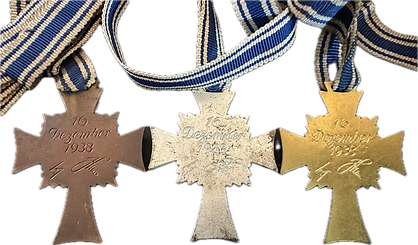



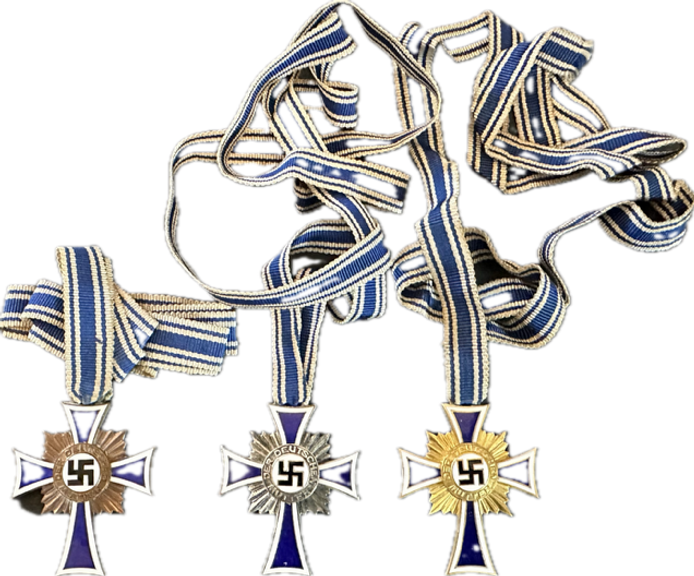
3 Mothers Crosses, in Bronze, Silver & Gold grade.
This award was instituted on 16 December 1938. The idea was to encourage German women of childbearing age to increase the size of their families and thus the population of the Third Reich. The Cross of Honour of the German Mother (Ehrenkreuz der deutschen Mutter) came in three classes. The third class in bronze was awarded to mothers bearing three to five children. The second class in silver to those bearing six to seven children, and the first class in gold for eight or more children . Only families of pure German origin were considered as qualifying for the award. The first awards were made in May 1939 and the last in 1944
Scarce German 20mm MGFF HE/I cannon round








Scarce 20mm MGFF HE/I cannon round. Primarily used in aircraft but was gradually replaced by the MG151/20 from 1940. This example has a 1940 projectile with original paint with faint overprinted inspection and batch marks. Fitted with an alloy Kph.Z.Zert.Fg. fuse mounted in a brass washed 1940 dated case. Case has an audible indicator of its inert status
Luftwaffe Unteroffizieren of the 4./ Schw. Flak 404 (o) unit signed album


A very interesting Photo / autograph album depicting the Unteroffizieren of the 4./ Schw. Flakabteilung 404 (o) unit. "Non-commissioned officers of the 4th/Schw. Flak 404 (o) unit".
Filled out with photos, most of which have the handwritten signatures to match the subjects below. I have never seen one like this before now, real piece of history!
2 GERMAN LUFTWAFFE ISSUE RIBBON BARS






First one, consisting of the 2nd Class Iron Cross,2nd Class War Merit Cross with swords device and long service medal with its eagle attached, to the rear its attaching pin.
Second one double Luftwaffe long service medal bar with eagle devices still attached. to the rear its attaching pin. Both in excellent condition
